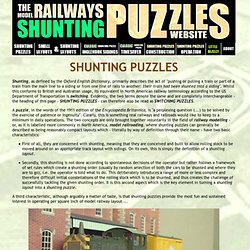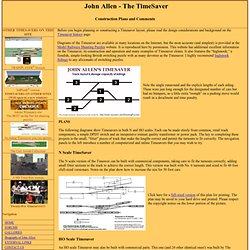

Do it Yourself in Z-scale. Society - Horsley Bank. Llangunllo. Voir le sujet - dételeurs magnétiques.. Mais c'est un truc que TOUT LE MONDE connaît ou devrait connaître Première phaseMatière première : un blister en plastoc transparent quelconque.

Outils : une paire de ciseaux, des doigts. Dans le blister, découper des rectangles d'environ (ce n'est pas critique) 6 mm de large et 5 à 6 cm de long. Avec les doigts, courber chaque rectangle en forme de vague, comme ça, à peu près : Deuxième phaseMatière première : un tout petit clou. Voilà, c'est fini. Comment ça marche ? Si les wagons se détellent sur un train en marche, c'est - que votre dételeur est trop haut, ou - que votre plastique est trop raide, ou - que le bout "libre" est coincé par un grain de ballast... Si les wagons ne se détellent pas c'est - que votre dételeur est trop bas, ou - qu'il est trop souple, ou - qu'il est trop court. Défauts du truc : Quand il est au premier plan, on le voit un peu et ça ne ressemble à rien, COMME QUASIMENT TOUS les dételeurs du commerce. TMRC - Tech Model Railroad Club of MIT. MODEL RAILWAY SHUNTING PUZZLES. Shunting, as defined by the Oxford English Dictionary, primarily describes the act of "pushing or pulling a train or part of a train from the main line to a siding or from one line of rails to another: their train had been shunted into a siding".

Whilst this conforms to British and Australian usage, its equivalent in North American railway terminology according to the US Department of Transportation is switching. Evidently, the two terms denote the same and are completely interchangeable - the heading of this page - SHUNTING PUZZLES - can therefore also be read as SWITCHING PUZZLES. A puzzle, in the words of the 1911 edition of the Encyclopedia Britannica, is "a perplexing question (...) to be solved by the exercise of patience or ingenuity". Clearly, this is something real railways and railroads would like to keep to a minimum in daily operations. Timesaver Shunting Puzzle - Rules & Operation. On the original Timesaver layout, John Allen marked out the destinations for each car before each game session and then set up the cars in their "starting positions", which also stayed the same for every round of the game.

Time was a key element in the game (as the name implies): you had to make the right switching moves to get the cars to where they were supposed to end up, but you also had to do it as quickly as possible. This also meant that apart from thinking ahead to do as little switching as possible you also had to be nimble with the controls for the locomotive (which on the original Timesaver operated with a set speed, so you could only change the direction of travel of the locomotive). Des plans de voies denses. Sur cette page vous trouverez tous les plans sur un thème en lien avec la zone industrielle.

Les plans de réseaux sont issus du site de Carl Arendt avec l’aimable accord du webmaster. J’ai sélectionné quelques plans de réseaux postés sur son site. Voici quelques exemples de plans de réseaux denses ; par dense j’entends avec beaucoup de voies sur peu d’espace. Il existe un grand nombre de solutions pour réaliser un réseau sur une étagère. À gauche un réseau étagère de 23x90cm. À droite Emrys Hopkins à réalisé un arrangement des voies très astucieuses sur une surface de 30x90cm. John Allen's Gorre and Daphetid Railroad - The TimeSaver. Before you begin planning or constructing a Timesaver layout, please read the design considerations and background on the Timesaver history page.

Diagrams of the Timesaver are available in many locations on the Internet, but the most accurate (and simplest) is provided at the Model Railways Shunting Puzzles website. It is reproduced here by permission. This website has additional excellent information on the Timesaver, its construction and operation and many examples of Timesaver clones. It also features the “Inglenook,” a fiendish, simple-looking British switching puzzle with as many devotees as the Timesaver. I highly recommend Inglenook Sidings to any aficionado of switching puzzles.
Note the single runaround and the explicit lengths of each siding. The following diagrams show Timesavers in both N and HO scales. N Scale TimeSaver Click here for a full-sized version of this plan for printing. HO Scale Timesaver An HO scale Timesaver may also be built with commercial parts.